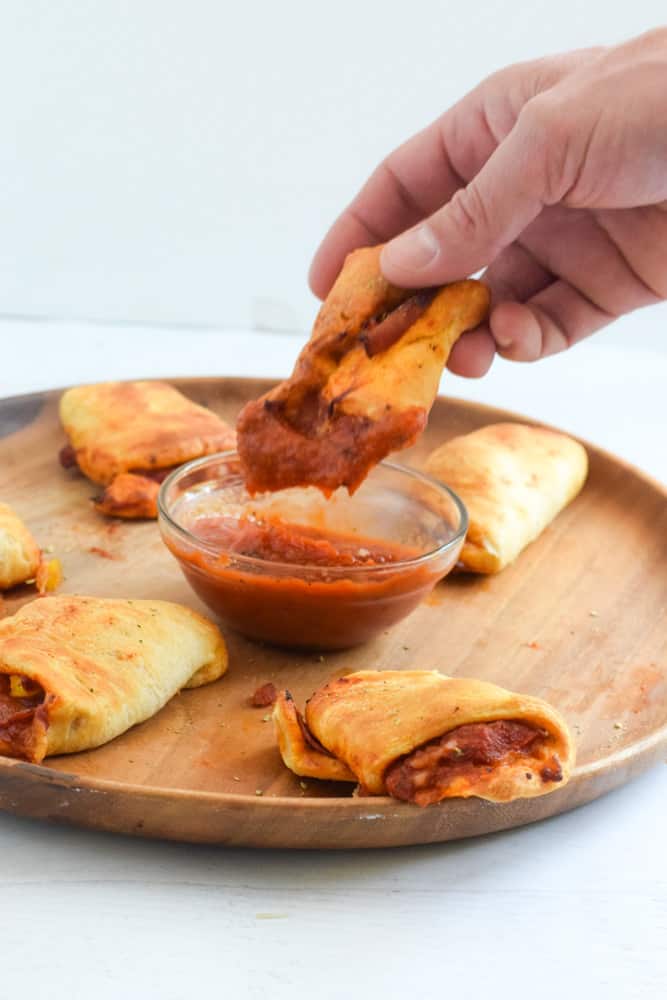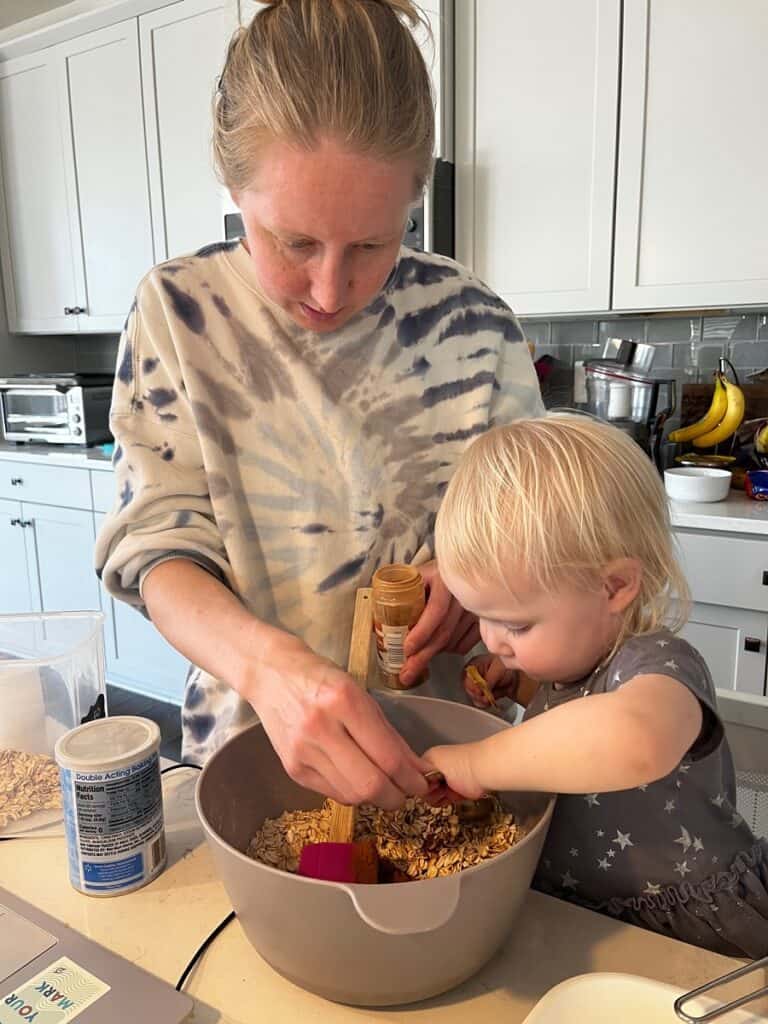Intuitive Eating for Kids: Tips on Raising Intuitive Eaters
- May 19, 2021
- Last Updated: May 30, 2024
- 0 Comments
- Intuitive Eating
We all want to model intuitive eating for kids, but how exactly do we do that? As a mom, I’m so much more cognizant about the language I use towards and around food and here are some of my top tips for raising intuitive eaters.
As an Amazon Associate, I may earn from qualifying purchases. You can read more here about our Disclaimer and Privacy Page.
When talking about intuitive eating to kids, it’s important to first check yourself.
Things that didn’t seem like a big deal to me could become a big deal for kids, and raising intuitive eaters is very important to me.
I recommend all parents read some of the intuitive eating books to get more background about why this is the case.
Kids have an instinct to eat when they’re hungry and stop when they’re full, and this actually starts when they’re babies.
There is some interesting research about spoon-feeding babies vs. doing baby led weaning where they can learn to self-regulate food.
We wrote more about that in our blw vs puree approach to starting solids.
While many adults don’t do this and have an unhealthy relationship with food, kids are natural intuitive eaters – before diet culture hits them.
Grab Our Meal Prep Ebook to Finally Conquer Meal Prep in the Kitchen

My daughter has an unhealthy relationship with food is something NO parent ever wants to say.
Especially once you understand the division of responsibility in feeding, explained below.
As a parent, there are ways you can nurture this healthy way of eating in your child, like trying these food activities for kids, to make food fun.

I really want to create a safe, respectful and nurturing environment around food in our house.
To do so, I’ve really learned a lot about intuitive eating for kids.
So, I figured I’d walk you through some of the ways we approach food among the 10 principles of intuitive eating to support raising a healthy happy eater and make mealtimes enjoyable for all.

Challenges of Feeding Toddlers
Truthfully, the toddler years are difficult with food.
They like something one day, and despise it the next. They want to throw food, make a mess, and suddenly become pickier overnight.
Some days they eat less, and other days they have a ravenous appetite, as I talked about when I shared ideas for what my toddler eats in a day.
We actually still make a lot of these sweet potato recipes for baby led weaning because they are normal staples in our diets, too.
You don’t always have the energy to “meal prep” which is why freezable toddler meals can be life savers, by the way.
That’s just the nature of the ballgame.

As parents, of course, we want the best for our children, and I really feel that making food fun for toddlers plays a role.
We want to tell them to “eat all the vegetables first,” or that they can’t have dessert until they finish dinner.
We want them to learn to listen to their bodies, especially when you’re packing kid snacks for road trips.
But, have you ever considered the strict rules offered (out of love and concern, of course) may be working against you?

If you’re wondering how to get toddlers to eat vegetables, this is how to approach it. And don’t give up if you have picky eaters.
Try these healthy snacks for picky eaters and the tips involved.
The Division of Responsibility in Feeding
In Ellyn Satter’s Division of Responsibility in Feeding you (as the parent) are responsible for the when, what, and where when it comes to feeding your child.
Your child is then responsible for how much they eat and whether they eat a specific food.
This method of feeding helps prevent and solve feeding issues and helps your child to become a competent eater.

When you stay in your lane of responsibilities, you’ll help your child to trust their bodies and their own intuition about food.
Once we serve the food to children, it is not our job as parents or caretakers to make them eat it. We have to leave them some autonomy.
This is the only way that intuitive eating for kids happens.

It’s important to understand the division of responsibility in child feeding practices.
Having too much input from parents can be overwhelming for kids, and parents may be unintentionally creating rigid rules that take kids away from listening to their bodies.
Ellyn Satter is a dietitian, family therapist, and child feeding expert.
She has several resources that describe what normal eating is and how to foster a safe environment to do so.
With her division of responsibility in mind, here are some ways we help incorporate those practices in our house.

Create a Meal and Snack Routine
As previously mentioned, as a parent, you choose the times that you offer meals and snacks.
Sticking to a schedule, as best as you can, is important so that kids know what to expect and when to expect it.
Even if you’re offering healthy toddler snacks on the go, try to stick to the usual schedule they follow. This will make everyones’ lives easier.
Kids like routine. It’s much easier for a child to eat until they are comfortably full when they know they will have another chance to eat a few hours later.
Following a routine schedule can also help increase the amount your child eats at meals and limit the constant snack begging in between, which makes mindful eating for kids a much easier process.

Make Mealtime Enjoyable
If mealtime makes you want to pull your hair out, you’re not alone.
When there’s a power struggle over eating vegetables or finishing food, no one’s happy. We try to serve some of these vegetable recipes for toddlers for the whole family to enjoy so they see that we aren’t singling them out.
Create an environment that’s calm and enjoyable, not full of chaos and nagging, even if it’s a Wednesday night dinner.
When possible allow yourself enough time to prepare and serve food before everyone is too hungry.
Turn off the TV and put away the phone.
Use this as a time to sit and eat with your children and engage with them in fun conversation.
If you have the time, try making a few meals a week into a fun sensory activity.
This could include:
- Making a face or scene out of their fruits and vegetables.
- Putting different colored foods on their plate.
- Cutting their sandwich with a fun shaped cookie cutter or sandwich cutters.

While these meal activities are fun for the child to see and experience, it also provides an opportunity for conversation about the food.
Instead of “eat your broccoli” this could open the door to say, “what colors do you see on your plate?” or “what does the face’s nose taste like?”
These fun experiences can increase interest in the food item without placing any pressure on the child.
Get Creative With the Food You Offer
You’ve put broccoli on your child’s plate for 3 weeks now with no success. It ends up on the floor each and every time.
Is it time to throw in the towel and accept that your child will never like broccoli? No way! You just need to get creative.
This is top of mind too when talking about intuitive eating for teens. They don’t want to eat the same thing all the time!

If your child has refused a specific food time and time again, start thinking of ways you can change up how you offer it.
Using broccoli as an example, instead of the typical stalk of broccoli on their plate, you could try:
- Sprinkling the florets in their mashed potatoes.
- Serve it with their favorite dip.
- Make or buy cheesy broccoli nuggets.
- Mix it with mac and cheese.
- Mix it into a healthy muffin for baby.
- Roast it, steam it, or offer it raw (try a different method of cooking).

Kids are masters at doing the same thing over and over. If they think they hate something, it probably won’t change just because you keep putting it on their plate (in the same way).
Offering a food in a new way is a whole new experience for kids.
You might be surprised at what they will try when the method of preparing or offering it changes.
And if they don’t? Don’t sweat it. Just keep offering healthful foods in a variety of ways. Consistency is key.

Allow Your Child Freedom On Their Plate
You’ve established meal and snack times. You’re offering a variety of foods. Some your child likes and some you wish your child liked.
Now you need to kick your feet up and let your child do the rest. Remember, once you serve the food, your job is done!

It’s important to avoid pressuring your child to eat certain foods or finish their meal. Whether it seems they’re in the mood to please or defy you, adding that extra pressure keeps them from listening to their body.
When teaching your child how to be an intuitive eater, it’s important to remember what intuitive eating is at its core.
They need to tune out external cues for eating and allow internal cues to determine what and how much to eat.
Just like some days you don’t want or feel like vegetables, they may feel the same way!
When you tell your child “take 5 more bites” or “eat your peas or you can’t have dessert” you are acting as that external force dictating what they eat.
Your child has the responsibility to choose what he wants to eat and how much he wants to eat to be satisfied and full.

Model How To Be an Intuitive Eater Yourself
As scary as it may seem, your kids are always watching you. Your food choices or comments about food are noticed by your children.
Take a good look at how you approach eating and mealtimes and make efforts to show your kids how to eat intuitively through your own actions.
This post shows more about how to become an intuitive eater.
Do you label food as good or bad? Praise them for eating a vegetable? Limit their dessert if they don’t eat an “acceptable” amount at their meal?
All of these scenarios apply moral value to foods and create a lot of conflict about eating for children.

Talking about food in a neutral way and proclaiming just as much positivity about your dessert as you do your vegetables is a good place to start.
If you want to raise intuitive eaters, make sure you’re working on becoming one yourself.
After all, they’re watching and learning from you every day.
Ways To Encourage Mindful Eating For Kids
Your calm and enjoyable mealtimes are the perfect opportunity to encourage mindful eating habits for your kids. Instead of zoning out in front of the tv or reading while eating, explore how the food tastes, feels, smells, and looks with your kids.
You can also talk about hunger and fullness as your kids get a little older.
A great way is to lead by example, and the intuitive eating hunger scale can help you, as the adult, become more mindful and aware of hunger cues and signals.
Here’s some questions to encourage mindful eating for kids (toddlers and up!)
- What colors do you see on your plate?
- Is your carrot crunchy or juicy?
- What food on your plate smells like cinnamon?
- When I bite into my carrot I hear a “crunch”, what do you hear when you bite into yours?
- When I lick the grape I can’t taste it. But when I bite into it, it’s so juicy! Do you want to try?

What other ways can you get your kids involved in mindful eating activities?
Raising intuitive eaters is a tough job, especially if you’re working through your own food issues or body insecurities.
For more resources on intuitive eating, check out these posts:
- Intuitive Eating Resources
- Coping with Diet Talk
- What is Food Flexibility
- Intuitive Eating and Meal Planning
Save This Post for Later

Support Bucket List Tummy









Like This Content?
Support Bucket List Tummy